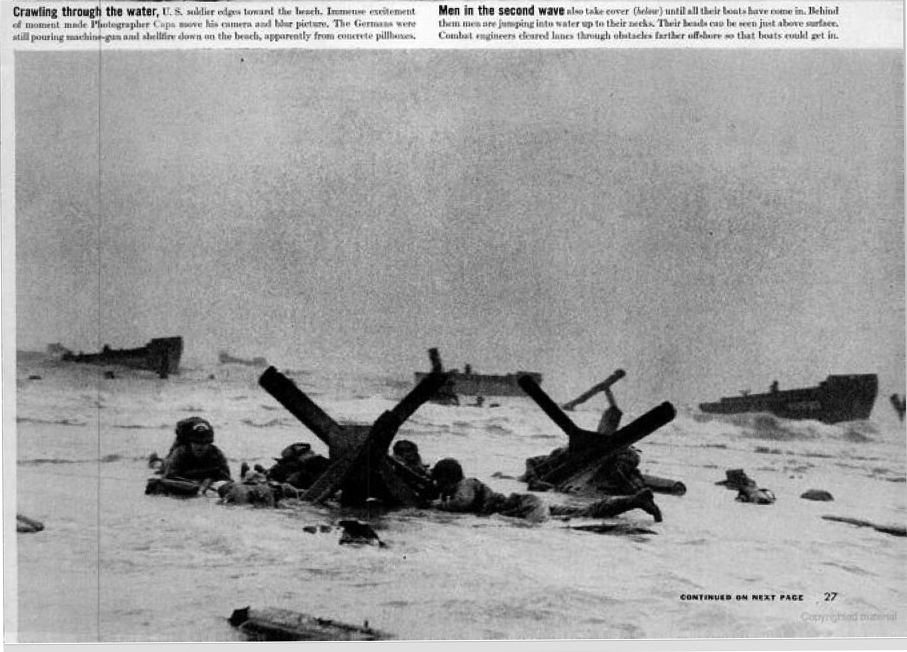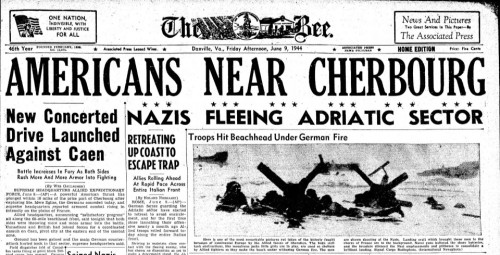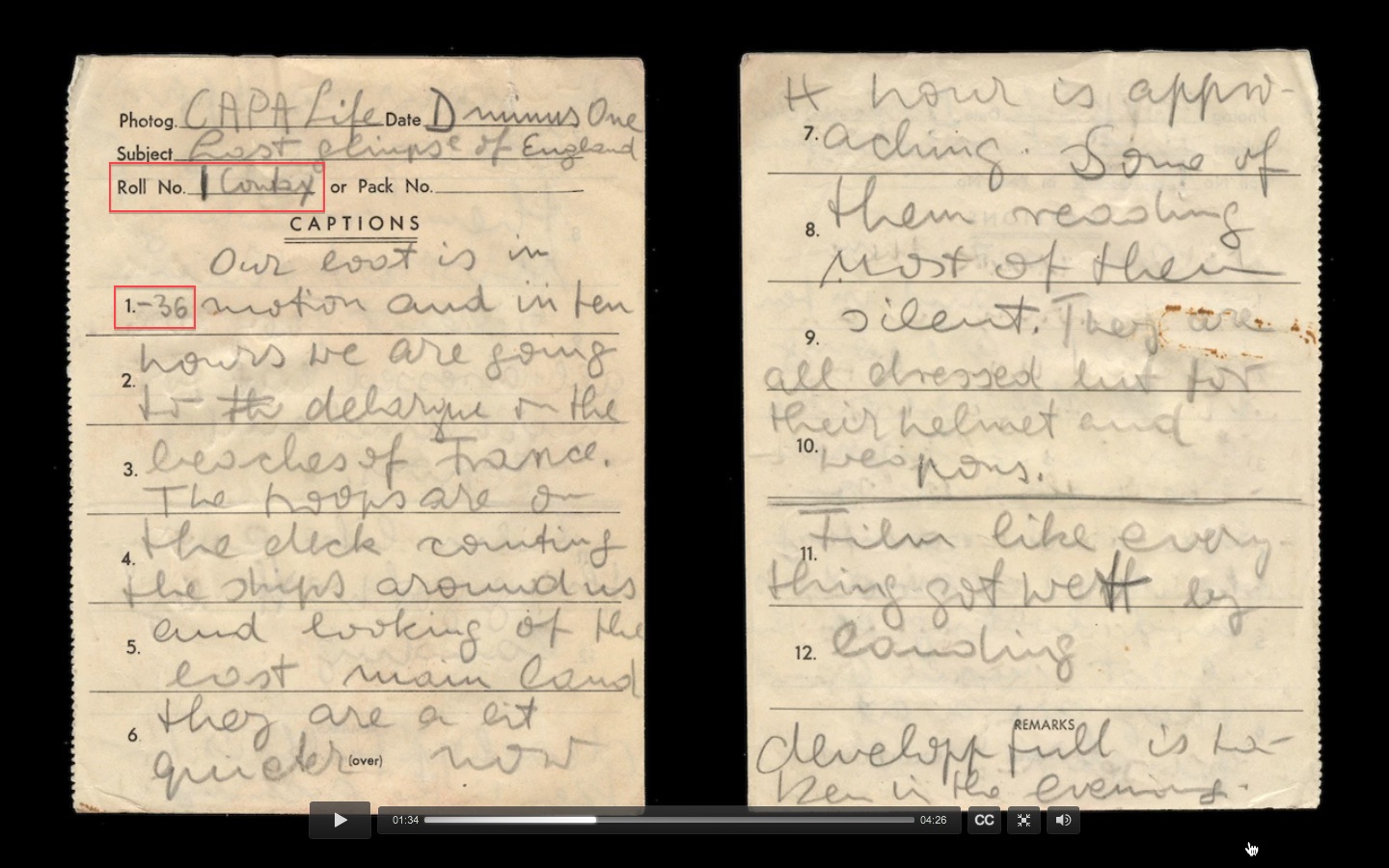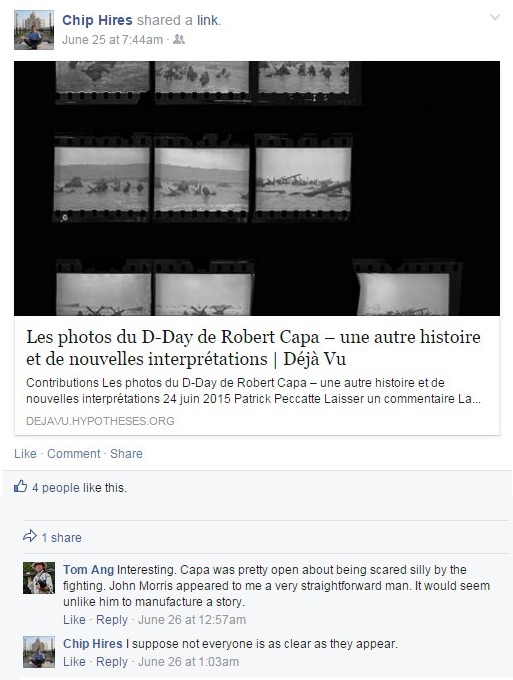 The French Connection (continued)
The French Connection (continued)
In the first part of my discussion of D-Day researcher Patrick Peccatte’s thoughtful, detailed analysis of our Capa D-Day inquiry, I ended with his remarkable acknowledgment of the intellectual and emotional difficulty he’d experienced in engaging with, absorbing, and ultimately accepting the evidence we have presented over the past year to substantiate our arguments. Click here for his article, “Les photos du D-Day de Robert Capa – une autre histoire et de nouvelles interprétations,” dated June 24, 2015. (Tacitly, Peccatte’s testimony broaches a much larger question that certainly pertains to this investigation but reaches far beyond it: the seductiveness of an entrancing narrative as evidence of our deep, perhaps even hardwired addiction to “stories.” I plan to explore that subject at some length in the future.)
In the event, after that confessional passage Peccatte takes up Charles Herrick’s analysis of Capa’s seventh D-Day exposure — negative 35 on his D-Day roll — showing what Herrick identifies therein as engineers blowing up Nazi obstacles. In addition to indicating that he and his team find Herrick’s analysis “seductive and convincing,” Peccatte appends a reproduction of an appearance of that particular image of Capa’s in The Bee (Danville, Virginia), datelined June 9, 1944, along with the caption that ran with that reproduction and similar ones in a dozen other newspapers — all of which reiterate the fiction that the picture shows troops hiding from enemy fire, the same fiction that Herrick has impeached. (Peccatte gives the captions in English as well as French, so you can access that part of his post even if you don’t speak French.)
He adds to this a reproduction of the recto and verso of the earliest known surviving example of a Capa D-Day radiophoto, Capa’s negative 34 (the one preceding the image of the engineers that Herrick analyzed), along with the caption that accompanied it and the captions that LIFE and a dozen papers gave to it. (Bernard Lebrun, co-author with Michel Lefebvre of the 2012 book Robert Capa: The Paris Years, 1933-1954, discovered this print recently.). This image was transmitted wirelessly by the press pool on June 8, the same day that Morris delivered these images to the pool and shipped them to LIFE in New York.
We know, from the caption sheets Capa sent to John Morris with his films and from Morris’s own account, that Capa himself captioned only his pre-invasion exposures, not the ten Omaha Beach negatives. Morris has explained that he had the LIFE darkroom generate four identical sets of prints: one for the censors, one for SHAEF headquarters, one for the press pool for wirephoto distribution, and one (with the pertinent negatives) for shipment to LIFE‘s head office in New York. We can safely assume that each of those prints had a caption attached to it, presumably generated by Morris himself; that would have been required by the designated recipients, and would have numbered among his mandatory tasks as picture editor.
Since Capa provided no caption information for his pictures of the Omaha Beach landing, Morris would have had to make those captions up himself. Given that, unlike Capa, he had no combat experience, Morris understandably could have failed to recognize the engineers at work on the demolition of the hedgehogs, just as he could have failed to realize that the troops visible well ahead of Capa in the photographer’s first five exposures represented first-wave arrivals who had preceded Capa to Easy Red by an hour or more.
As Peccatte acknowledges in his post (following an email exchange between us on this subject), it remains unclear whether the press pool simply duplicated Morris’s captions and sent them out verbatim, or else modified them before distributing the images wirelessly to their members. Forinstance, the caption attached to the June 8 wirephoto described above reads as follows (click on image to enlarge):
“Working through beach obstacles men are seen struggling through water up to their necks on French coast. Machine gun fire took its toll here. ACME PHOTO BY SIGNAL CORPS RADIOTELEPHOTO FROM LONDON.”
(The first sentence is of course careless and wildly inaccurate, by any standard. The engineers in this pictures are visibly not in “water up to their necks,” even though they are lying prone on the wet sand. They’re not “working through beach obstacles,” nor “struggling through” the water; they’re staying in place deliberately, carefully planting explosives to demolish several hedgehogs. The second sentence is effectively generic, thus meaningless; there’s hardly a section of the beach to which that would not apply that day.)
Similarly, we don’t know if LIFE ran Morris’s captions as he wrote them, revised them for publication, or wrote their own from scratch. Given the seven decades in between, Morris himself may not recall this detail, though it’s a question someone should put to him; I regret that it hasn’t occurred to me until recently. (One of those four original sets of prints, with its captions, may survive — at LIFE or in the archives of SHAEF, the U.S. Army’s censorship division, or the press pool.)
In any case, as Peccatte’s post makes clear, the publications through whose pages these pictures (and others) found their way to to the public felt free to reword, expand, and embellish whatever captions they received as they saw fit, even if those doing the revising were thousands of miles away from the events depicted.
•
Peccatte’s post evoked a number of considered comments. It also attracted the attention of someone who refused to identify himself by anything but his first name (“Jean Pierre,” itself possible a pseudonym), but waxed indignant over Peccatte’s article — which he’d browsed quickly — and our research project, which he’d clearly never read. He wrote, among other things (my translation),
“Capa was a great photographer, he was responsible for the creation of Magnum with 3 other prestigious photographers. The four founders of the Magnum agency are: Robert Capa, David Seymour, Henri Cartier-Bresson, George Rodger. May their memory be honored forever. Those who besmirch them should be well aware that they dirty only themselves in doing so.”
Unmistakably, another fanboy. More evidence that, among the true believers, nothing less that unquestioning hagiography suffices. I suspect “Jean Pierre” functioned here as a designated hit man for Magnum, since that agency’s Patrick Zachmann had already served in that capacity, attacking me in public at the Athens Photo Festival in Greece a month earlier for daring to challenge the myth.
I concluded one of several responses to these rants from “Jean Pierre” by writing, “I encourage you to identify yourself fully, in order that we can assure ourselves of your bona fides and confirm that you’re not a stalking horse for the Capa consortium, a troll, or both.” That apparently infuriated him to such an extent that he resorted to ad hominem attacks before declaring himself victorious, announcing his decision to cross Peccatte’s site off his list, and riding off in his Huff. I commented thus on his arrival and departure:
 Patrick Peccatte proves himself much more indulgent than I. At my blog, I approve no comment from any source who refuses to sign with a full name and whose identity I cannot verify. I consider that a basic requirement for participation in public discourse among adults.
Patrick Peccatte proves himself much more indulgent than I. At my blog, I approve no comment from any source who refuses to sign with a full name and whose identity I cannot verify. I consider that a basic requirement for participation in public discourse among adults.
Typically, stalking horses and trolls like our mysterious “Jean Pierre” declare unilaterally that they have won the argument and depart the field when challenged.
I suspect we have here a disciple of Pierre Bayard, since M. “Pierre” in his commentary exemplifies the approach advocated in Bayard’s popular 2007 instruction manual, How to Talk About Books You Haven’t Read (Comment parler des livres que l’on n’a pas lus?).
Bayard’s book reached the best-seller lists in France when it appeared in 2007, I might add.
•
Word Spreads
This deconstruction of the Capa D-Day story has legs, and has started to take on a life of its own. Peccatte’s post was noted by Prof. Lyonel Kaufmann, who teaches the teaching of history at the Haute Ecole Pedagogique Vaud (HEP-VD) in Lausanne, Switzerland. In a post at his own blog, aimed in part at his own students and other teachers and students of historianship, he directs visitors to our research and Peccatte’s post about it. He quotes Peccatte’s confession of his own change of heart and mind, discussed above, commenting, “This work of Patrick Peccatte’s is remarkable for its thoroughness and intellectual honesty.” I couldn’t agree more.
In a July 4, 2015 post at the site Arrêt sur images.net, Alain Korkos published “Robert Capa: le photographe était presque parfait.” Therein he weaves our investigation into a long chain of lies and half-truths that extend across Capa’s entire career. Devoted to “critical reflection on media,” this multi-author site regularly addresses issues of image manipulation and other deceptions involving photogrphy. Peccate informs me that the site is well-known and respected among French readers of photo criticism.
And Charles “Chip” Hires, an independent photojournalist (formerly with the Associated Press and Gamma/Liaison), who covered the 1989 massacre in Tiananmen Square and other major stories, posted a link to Peccatte’s account of our project and his change of heart at his own Facebook page. When Tom Ang commented that “John Morris appeared to me a very straighforward man. It would seem unlike him to manufacture a story,” Hires replied, “I suppose not everyone is as clear as they appear.”
•
![]() The estimable Peter Marshall, who has tracked this project from the start at his U.K. blog >Re: PHOTO, has posted a substantial response to this research from Charles Herrick: “Capa’s Story,” datelined June 10. I commend it to you in its entirety. An excerpt:
The estimable Peter Marshall, who has tracked this project from the start at his U.K. blog >Re: PHOTO, has posted a substantial response to this research from Charles Herrick: “Capa’s Story,” datelined June 10. I commend it to you in its entirety. An excerpt:
“As this case demonstrates, [serious criticism] often … needs some specialist knowledge … But in this case, perhaps more than anything else it needs the courage to think out loud the unthinkable, that people and institutions that have been revered for years have been deliberately repeating a lie. Or in this case, perpetuating lies and a mistaken interpretation.”
In response, I wrote this to him:
I also want to second the larger points you have taken away from this project: That we need to maintain a critical relationship to powerful individuals and institutions and even the seductive stories we’ve come to believe and love. As Confucius wrote, “When everyone dislikes something, it should be examined. When everyone likes something, it should be examined.” (Analects 15:28.)
And that, for that purpose, we need practitioners of what I call “knowledge-based criticism” (and of course knowledge-based historianship, knowledge-based theory, and knowledge-based curatorial practice). I’ve adopted the term from Thomas Patterson, the U.S. journalism expert, who several years ago issued a call for knowledge-based journalism.
•
As Donald Winslow wrote recently in a May 11 Facebook post, “[You get cynical] after you see the ‘truth’ get uncovered time and time and time again. Investigative journalism is a lifetime of uncovering other people’s and government’s lies.” This from the Robert Capa and John Morris fanboy who, in his role as editor of the official journal of the National Press Photographers Association, commissioned another Capa/Morris fanboy, Bruce Young, to write a feature article dismissive of our research, violating every tenet of journalistic ethics regarding full disclosure and conflict of interest by publishing the result in News Photographer.
This man has no shame; his hypocrisy truly knows no bounds.
•
(For an index of links to all posts in this series, click here.)














Thank you for your visit and for mentioning my post.